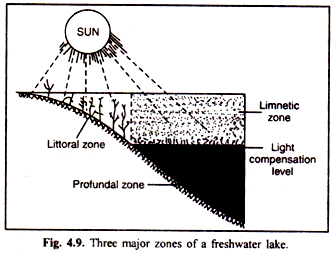Fresh water habitats are classified based on their chemical and physical properties. Those with standing water such as lakes and ponds are called lentic habitats and those with running water are lotic habitats. Most fresh water is locked up in ice sheets, glaciers, or is in ground waters such as lakes and rivers. These provide microbial environments that are different from the larger oceanic systems in many important ways.
For example, in lakes, mixing and water exchange can be limited. This creates vertical gradients over much shorter distances. Changes in rivers occur over distance and/or time as water flows through river channels.
Lakes
Lakes vary in nutrient status. Some are
oligotrophic or nutrient poor; others are eutrophic or nutrient-rich. Nutrient-poor
lakes are oxygen saturated, has low organic matter and a low microbial
population. Nutrient-rich lakes have
bottom sediments that contain organic matter and oxygen poor bottoms.
When large amounts of
nutrients are added to water, eutrophication (nutrient enrichment) takes place
and stimulates the growth of plants, algae, and bacteria. Because nitrogen and
phosphorus frequently limit microbial growth in freshwater habitats, the
addition of nitrogen and phosphorus compounds has a particularly large impact
on freshwater systems. Both cyanobacteria and algae can contribute to massive
blooms in strongly eutrophied lakes.
Lakes are divided into three zones, based on penetration of the light.
1)
Littoral
zone-
where light penetrates into the bottom- occupied by submerged or partially
submerged higher plants and attached filamentous and epiphytic algae.
2)
Limnetic
zone
– area of open water away from the shore.
Littoral
and limnetic zone together form the euphotic
zone, where photosynthesis occurs. Limnetic zone extends to a level known
as compensation depth.
The compensation depth is the lowest level having effective light
penetration. Photosynthetic activity balances respiratory activity, here. Photosynthesis
occurs at lower levels below compensation depth.
3) Profundal zone- the area of deeper water beyond the depth of effective light penetration. Absent in shallow lakes. In deeper lakes, it extends from the light compensation level to the bottom.
Littoral and limnetic zone form the euphotic zone. Below
euphotic zone is the aphotic zone
with no light penetration.
Euphotic zone mainly has primary producers such as phototrophs. Profundal zone has secondary producers who depend on the transport of organic compounds from the upper zone. The lake bottom called, benthos is the interface between hydrosphere and lithosphere. The lithosphere seen at the bottom of lake is called sediment and is occupied by many microorganisms.
Thermal stratification of Lake
Lakes have different layers/strata depending on the temperature of water. This thermal stratification of a lake according to temperature and depth is seasonal. There is an aerobic epilimnion (warm, upper layer) and usually anaerobic hypolimnion (deeper, colder, bottom layer) if the lake is nutrient-rich). The epilimnion and hypolimnion are separated by a zone of rapid temperature decrease called the thermocline, and there is little mixing of water between the two layers.
Hypolimnion –
low temperature, low oxygen, poor light penetration, restricted photosynthesis
As seasons change, the aerobic surface water and the anaerobic subsurface water will turn over as the result of differences in temperature and specific gravity. After such mixing occurs, motile bacteria and algae migrate within the water column to again find their most suitable environment.
In
addition to temperature and light, concentrations of organic and inorganic
nutrients, oxygen, salt concentrations and acidity affect microbial growth and
distributions in lake.







No comments:
Post a Comment